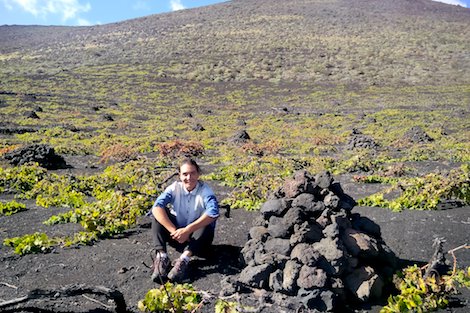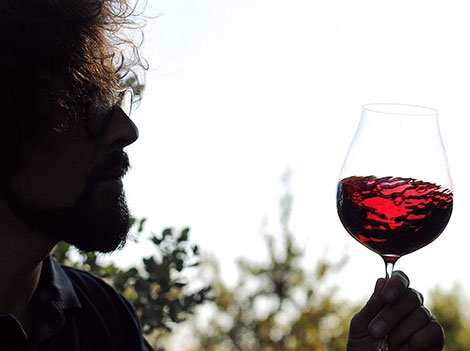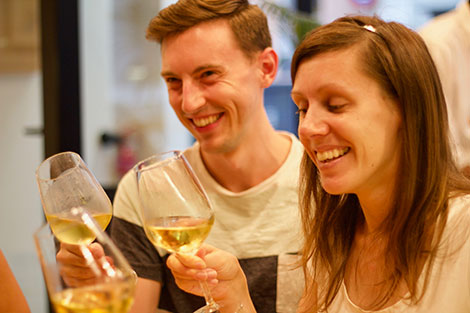Matías i Torres, in the vanguard of quality wine in La Palma

Victoria Torres is one of those people who seem to have a special connection with the place where they come from. Reflective and with a permanent smile on her face, this mild-mannered woman with exotic features, tenacious character and a warm gaze is at the forefront of wine quality production in La Palma, an island with volcanoes, rugged and captivating wind-swept landscapes and the omnipresent ocean where the stars shine with special intensity.
Her base is Fuencaliente, on the south of the island, an area on the foothills of the Teneguía volcano whose economy relies on tourism first and then bananas and wine grapes, an order which modern life has imposed over the years. That’s where she lives and has her little winery, built by her ancestors. It has undergone several extensions —the last one, around 20 years ago, was done by her father, Juan Matías Torres. “The need to adapt to the rules of the DO [established in 1994] forced him to purchase a horizontal press and stainless steel tanks. That’s why our whites stopped being pressed in the lagar and swapped chestnut for stainless steel”, explains Victoria (Vicky), fifth generation of the Torres family from La Palma.
She has recovered the ancient lagar, made from local pine trees, dating from 1885. It is used to press three of the local varieties she works with —Malvasía, Diego (a white variety also known as Bujariego) and Negramoll— and has recently started to use concrete: “I look for purity and expression in my wines and concrete helps because it’s not as air-tight as stainless steel. It’s also very efficient in terms of energy consumption”, explains Vicky.
There’s the odd demijohn around (“to see the effect of the veil of yeast. It occurs spontaneously here sometimes”), new French oak barrels and old sherry butts brought by her dad from Chiclana in Sherry Country. She uses them for her Negramoll, her most planted red variety. Buying chestnut barrels was an emotional decision. “My father had just died and I felt the need to recover part of the tradition”, she confesses. “I regretted the impulse afterwards but I’m now happy with the result. It has helped me understand that things happen at their own pace, not at ours”.
Three years on the road
The loss of her father in 2015 was a painful emotional blow which forced her to face the challenge of managing Matías i Torres on her own and overcoming her insecurities. “I am always full of doubts; it’s just the way I am and I have to live with that. I’m still transitioning from my father’s style to mine”, she admits. Self-taught and without formal winemaking studies, Vicky joined the world of wine in 2009 in a rather unconventional way.
“I used to help my dad in the winery, but the vineyards were his sole responsibility. A German couple in the north of La Palma were looking for a young person to look after their old organic vines. My dad drove up to have a look at them and rejected the idea but I thought it was a good way of learning so I rented the vineyard in secret and for almost three years, I came and went from the south”.
It’s barely 50 km but on the narrow island roads, the journey can take up to an hour and a half; the long drives plus the work in the vineyard meant that Vicky was exhausted by the end of the day. “There were days that I took my tent and slept there”, she remembers. When her father found out, he felt a mixture of disbelief and pride. “We women have to earn our respect here”.
When she started to work at Matías i Torres, her dad’s range of wines included a red Negramoll, the impressive naturally sweet Malvasía that she still makes following his teachings and a single-varietal Listán Blanco (called Palomino in Jerez) from Las Machuqueras, one of her favorite plots from which she makes a single-vineyard wine. “He didn’t mention it on the label; it just said white. It was a reviled grape variety and posed a problem to sell the wine. This thing of not specifying information is a common practice in the Canary Islands”, she laments.
In an area where phylloxera never appeared, with such unique and special vineyards and so many local varieties which are not found anywhere else, it is rather disheartening to see that a fair amount of the production is diluted and suppressed with fruity, semi-sweet or wooden notes for local and tourist consumption. “I remember visiting some fine restaurants and being told that my Listán Prieto did not resemble the wines from Rioja or Ribera”, she says with a hint of sadness in her voice. “In the Canary Islands, that’s still the benchmark”.
Something that upsets Vicky is the lack of awareness towards rural life in an island that is a Biosphere Reserve. “People don’t value our heritage and live their lives without any consideration of their surroundings. The skills to manage the vineyards and the forests have been lost”.
Malvasía, the jewel under the volcano
Vicky remembers the 2009 fire that burned 2,700 hectares in the south of the island. “We had to leave everything behind and flee to the coast. My father drove his car, my mum hers and and I took mine. When I closed the garage door, the flames were at the entrance of the house. It must have been my dad’s longest night; imagine having to leave everything behind, unable to defend it and the long wait afterwards. Winds were blowing at 60 km/h, it was very hot and 144 buildings burnt down. Only a few homes were damaged but the fear stays with you always”.
The scars of the last fire, which engulfed 7% of La Palma’s surface in August 2016, are still visible on the road between Fuencaliente and Tazacorte, to the west. Burnt trees stand alongside lava flows from the eruption of the Teneguía volcano in 1971, which damaged some vineyards but increased the size of the island when the lava solidified.
Not far from the Teneguía, some 400-500 meters above the sea of white plastic covering a many banana plantations along the coast of La Palma, Vicky drives us on her old jeep to Los Llanos Negros, a southwestern facing vineyard with spectacular views of the volcanoes and the ocean. There she owns three plots planted with Malvasía and manages a couple of small ones worked under organic principles, like the rest of the seven hectares of vines she has in Fuencaliente, the north and Hoyo de Mazo. These Malvasía vines lie on the volcanic lapilli soils, as it is traditional, taking advantage of the heat of the soil in the winter and favoring a more homogeneous and balanced budding.
“Malvasía is very demanding; dry-farmed vines are planted at very low density and the variety is very sensitive to oidium. That’s why it has been replaced by other varieties which are easier to grow. There used to be vines along the coast to Las Indias, further north; a lot of it has disappeared even though a kilo of Malvasía can fetch up to five euros. Luckily, in Fuencaliente we have Los Llanos Negros, where Malvasía grows under quality criteria”, explains Vicky.
Her complex and well-known Matías i Torres Malvasía Naturalmente Dulce (50 cl, €50) is not produced every year; weather conditions and low yields are to blame —her best vintage so far has was 2012, when she made 3,000 bottles; in 2016 she barely managed 30 litres. The idea of making Matías i Torres Malvasía Aromática Seca was the result of necessity (there was no sweet Malvasía in 2014 and 2015) as well as of a desire to explore the potential of the variety. The dry version displays great aromatics in contrast with a dry, austere palate with balanced acidity.
Chains to combat the wind in Las Machuqueras
On the southern slopes of the San Antonio volcano, under a black ridge facing the ocean, lies Las Machuqueras. Vines, protected by walls called cadenas (chains), crawl along the lapilli defying the northwesterly winds that blow unrelentingly making it hard to even get out of the car. It is a bleak landscape where yields on a good year don’t exceed 3,000 Kg/Ha (even though the DO allows up to 6,000) and oidium is rampant —it is therefore not surprising that some growers abandon their vineyards. For Vicky, however, this place feels special.
“I like working here, with these amazing views; I find peace. I spend quite a bit of time alone, without hearing a single human voice; the only sounds here come from the wind and the sea. This area is populated by kestrels and an owl that keeps rabbits and lizards at bay; they give me no trouble at all. Having said that, after a whole month pruning on my own, in the middle of February, it’s not that nice!”, she jokes.
It’s an old ungrafted vineyard with vines aged between 45 and 100 years of age and very long arms. “The red plants are Negramoll and stand up a little higher; there’s a bit of Diego and Malvasía in between but most of the vines are Listán Blanco [with which she makes her single vineyard Las Machuqueras]. Varieties are harvested separately because they have different ripening stages. Listán Blanco comes first and the others are picked little by little, when we rember”, she says laughing.
Last year it wasn’t easy, though. She decided to get rid of the excess old wood but she pruned too aggressively, particularly considering it was a very mild year and the plants struggled to heal. She also had to replant dead vines —a traditional practice called margullar, where they are replaced by burying a shoot from a neighboring vine— and move many cubic meters of soil, by hand, something that few people practice these days. To make matters worse, 500kg of grapes were stolen from her vines in an already poor 2016 vintage.
“There was a moment when I felt desperate. Soils are not really taken care of much here, but I decided to prepare a fertilizer made at home with camel and goat manure. We loaded the 1,000 L tank onto my Land-Rover and watered the soil to revitalize it”. She also drew on the teachings of Jairo Restrepo, a Colombian-Brasilian expert on soil fertilization who travels the world helping farmers to be more self-sufficient. “One has to be brave and do unknown things that others value”, says Vicky, who shares the biodynamic principles and uses plant infusions “but without impositions”. Despite the troubles, Vicky is unperturbed and displays her sense of humor. “It’s a very quiet village; you can still leave cars unlocked, the key on the door of your house… only grapes are stolen”.
The contrast of the north
The fire in 2009 destroyed the harvest of white grapes in their southern vineyards so the Torres’s started to work in a vineyard planted with Albillo Criollo (a different variety to the rest of Albillos in Spain) in Garafía, in the northwest of the island. Both here, as in Tinizara, Tijarafe and Puntagorda, where she works with local winegrowers, vines sink their roots at 1,200 to 1,400 meters above sea level in red soil terraces plummeting onto the Atlantic Ocean. The sunsets here are truly exhilarating.
“Everybody makes wine for home consumption throughout the year”, explains Vicky after a winegrower invites us to visit one of the many cellars excavated on the rock that are used to make their wines and as a place for family and friends to gather. “Thanks to them, many of the vines in the island are still cultivated”, she says. “It is hard to find vineyards in the north; most of the contracts are valid for one year so it is difficult to invest and take proper care of the vines”.
These plots in the north, a cooler and less inhabited part of the island where the rain is more frequent, are the source of her Listán Prieto and Albillo Criollo single varietals (plus some Negramoll and a bit of Listán Blanco). Her total production stands at 16,000 bottles but she wants to increase that figure to 20,000. The wines can usually be found in Spain at Lavinia. See other options vía Wine Searcher.
There won’t be any Albillo this vintage —the heat wave that affected the north particularly has scorched the grapes. Despite this setback, Vicky is optimistic. “I have almost four times the amount of grapes in Las Machuqueras compared to last year and I’m very happy with the quality. We started to harvest in the south on August 11, ten days earlier than last year. We’ve had a few cool days which are proving very beneficial for the vines after the scorching heat”, she says. “Last year’s troubles have helped me understand that I have to accept my mistakes and understand that vintages come as they are. I am more confident now”.

Yolanda Ortiz de Arri
A journalist with over 25 years' experience in national and international media. WSET3, wine educator and translator
NEWSLETTER
Join our community of Spanish wine lovers






